A wet and cold start to the year
Welcome to the January monthly overview for MeteoTielt - Weather Station Tielt.
The first month of 2025 was characterised by changeable and cold weather. With an average temperature of 3.6°C and a lot of precipitation, it was a typical winter month. The sun was rarely seen, and the wind occasionally brought chilly moments. Here is an overview of the weather in January 2025.
Temperature trends
The month began with relatively mild temperatures, with maximum temperatures around 10°C on 1 and 2 January. This was followed by a slight cooling, with some nights around or just below freezing.
In mid-January, there was a clear dip, with several days where the minima dropped below freezing and the maxima remained limited to a few degrees above zero. This was followed by a more moderate period with mild days and temperatures returning towards 8-10°C.
Towards the end of the month, temperatures rose again, with some peaks above 10°C, resulting in a relatively mild conclusion to the month. The fluctuations between day and night temperatures were significant, which is typical for a changeable winter month.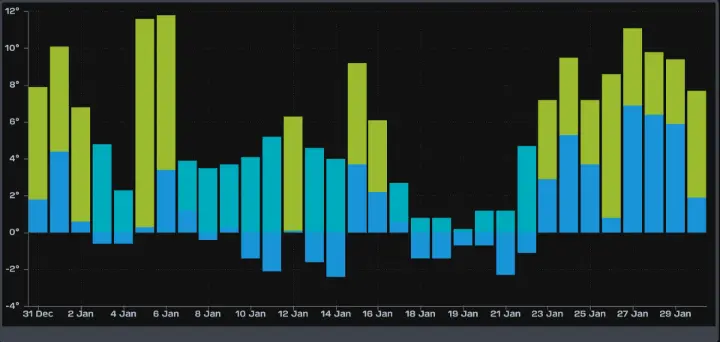
Precipitation:
The first month of the year brought a variable precipitation pattern in Tielt, with some days standing out in terms of rainfall amounts. Below is an overview of the main trends and notable days.
General Weather Overview
January 2025 experienced several wet periods, interspersed with drier intervals. The precipitation was not evenly distributed throughout the month; instead, there were a few days with exceptionally high rainfall amounts, while other days remained almost dry.
Precipitation Highlights
- 31 December & 1 January: The transition from the old year to the new brought a significant amount of precipitation, with a peak of around 20 mm on New Year's Eve.
- 8 to 10 January: A rainy period in which 10 January saw the most precipitation, with about 15 mm.
- 23 & 25 January: A new wet phase where these two days stood out with significant precipitation peaks around 15 to 18 mm.
- Last days of January: The month ended with a more even distribution of precipitation, without extreme peaks but with several days of moderate rainfall.
Dry Periods
Although there were some heavy rain showers, we also experienced longer dry periods. Particularly, the period between 12 and 19 January was notably dry, with only minimal precipitation.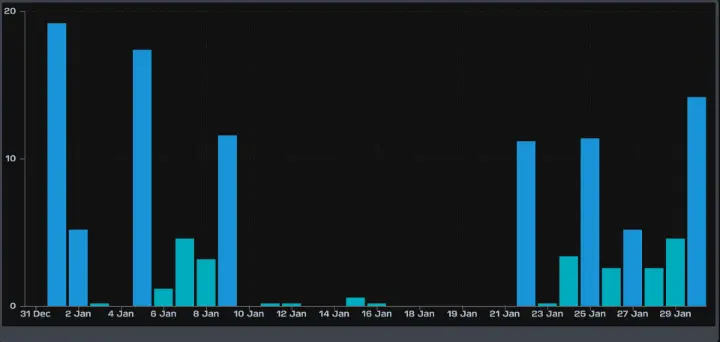
Wind:
The month of January in Tielt was clearly marked by wind, with interesting trends in both wind speed and wind direction. In this article, we analyse the data and highlight the most notable observations.
Wind Speed
The graph of wind speeds shows a clear variation throughout the month. The peak moments were mainly on 6 January, 23 January, and 27 January. On these days, the highest wind speeds were recorded, with peaks of up to 70 km/h, mainly due to strong westerly flows. Outside of these peaks, wind speeds were generally stable and moderate, with average values between 20 and 30 km/h.
What stands out further is that periods of more intense wind activity were often followed by calm days, indicating a typical alternation of disturbances and calm high-pressure influences in January.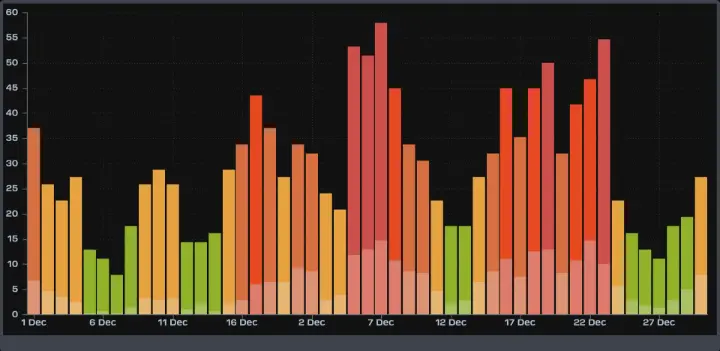
Wind directions
The wind directions in January were primarily oriented towards the southwest, as seen in the second graph. South-western and western winds dominated, which is typical for this time of year in Belgium. However, there were sporadic days with eastern and even north-eastern influences, which may indicate short periods of continental air flows.
These directions are associated with the prevailing weather systems in January, where low-pressure areas from the Atlantic Ocean directed the air flows in a western and south-western direction.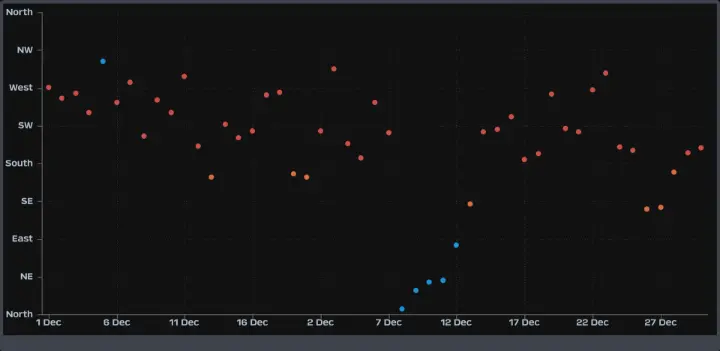
Sunshine and UV index:
A variable sun image
The data shows that there were a few distinctly sunny days, mainly around mid-January and towards the end of the month. This coincides with the peaks visible in solar energy production and UV index.
In the first week of January, there were some clear moments, with a notably sunny day on 2 January. This was followed by a period of variability, during which the sun only broke through occasionally. Between 10 and 16 January, there were several days of prolonged sunshine, which is also reflected in the increased UV values during that period.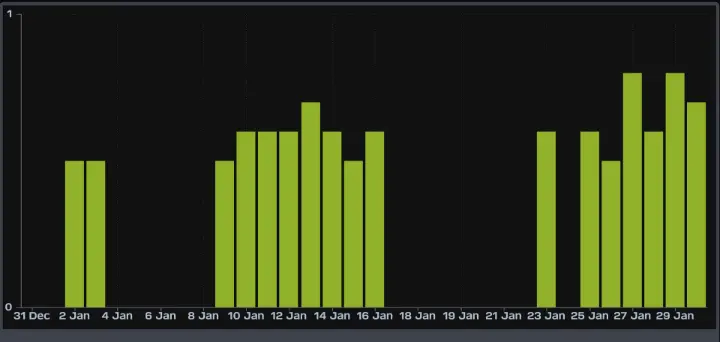
Second half of January
After a variable phase around 18 January, when the sun barely appeared, sunny weather returned from 23 January. The last week of the month brought the most hours of sunshine, with peaks on 27 and 29 January. This resulted in a relatively sunny end to the month, despite the shorter days.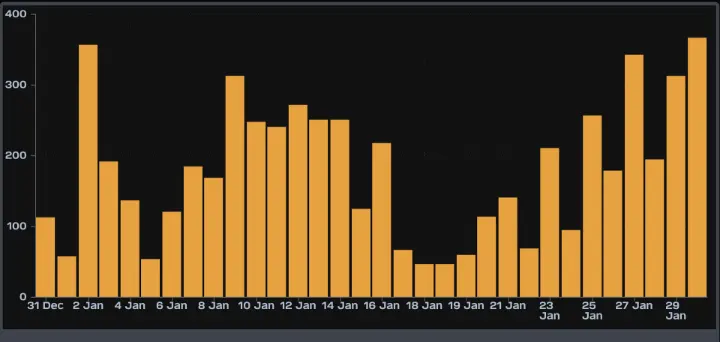
Air quality:
The air quality in Tielt experienced significant fluctuations in January, with days of relatively clean air alternating with periods of increased air pollution. This monthly overview provides a detailed analysis of the air quality index (AQI) and the associated health risks.
A changeable start
The month began with mixed air quality. On 1 January, the AQI was moderate with a value just below 100, while the following days showed improvement, with values falling into the green zone, indicating good air quality.
However, around 5 January, the AQI rose sharply, exceeding 100, indicating that air quality deteriorated to a level where sensitive groups may experience discomfort. This peak was followed by several days of fluctuating air quality, with the AQI varying between moderate and healthy levels.
Mid-January: Peak of air pollution
Air quality reached a concerning peak around 14 to 17 January, with the highest recorded AQI of 130.3 on 17 January. This falls within the 'moderate to high risk' category, meaning that people with respiratory conditions or other health issues needed to be extra cautious. The cause of this pollution may possibly be attributed to unfavourable weather conditions, increased emissions from heating, and limited air circulation.
Improvement towards the end of the month
After the peak in the second week, air quality began to slowly improve. The values gradually decreased, and around 24 January, moderate air quality was observed again. The last days of the month showed a significant improvement, with several days in the green zone, indicating clean air.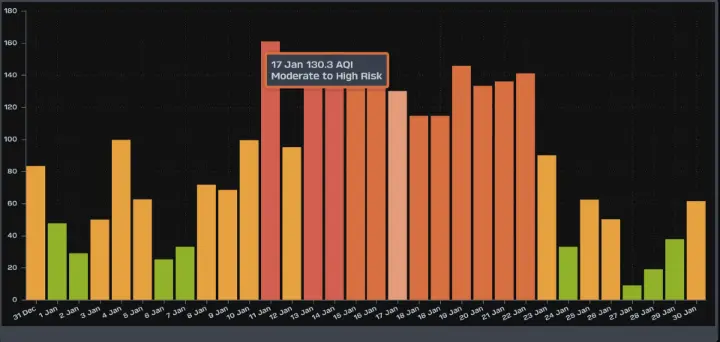
Conclusion
January 2025 was a typical winter month for Tielt, characterised by changeable and cold weather. The temperatures fluctuated significantly, with periods of frost interspersed with milder days.
Precipitation was irregular, with some wet periods and dry intervals. The wind played a prominent role, with a few stormy days and predominantly south-westerly winds.
Sunshine was scarce, but a few bright days provided relief from the gloomy winter sky.
Air quality experienced some peaks in pollution, particularly mid-month, but improved by the end.
All in all, January offered a dynamic and typical Belgian winter weather.
Stay updated on the latest weather developments with MeteoTielt - Weather Station Tielt!🌦️